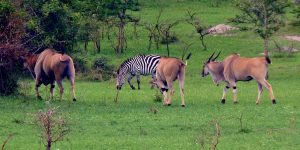What to expect on a safari to Lake Mburo National Park
What to expect on a safari to Lake Mburo National Park
What to expect on a safari to Lake Mburo National Park. Conveniently located close to the highway that connects Kampala to the western Uganda parks, Lake Mburo National Park is the smallest of Uganda’s savannah National Parks. The park comprises of Precambrian metamorphic rocks which date more than 500 million years back making it worth a Uganda safari.
Although not the leading tourism destination in Uganda, this 270 sq km park has numerous attractions that can spice up a visitor’s safari adventure. Lake Mburo National Park falls under the management of Uganda Wildlife Authority. Below are some of the attractions which you can enjoy on your trip to the place:
Here is What to expect on a safari to Lake Mburo National Park
1. Wildlife and game drives
 Lake Mburo National Park has a varied inhabitants that supports more than 68 mammal species. Among these mammals, there are some rare species like the Impala, which in this country only live in Lake Mburo, the Burchell’s zebra and eland which can also be found Kidepo Valley National Park. All these mammals make the place adventurous full of hard-to forget nature experiences.
Lake Mburo National Park has a varied inhabitants that supports more than 68 mammal species. Among these mammals, there are some rare species like the Impala, which in this country only live in Lake Mburo, the Burchell’s zebra and eland which can also be found Kidepo Valley National Park. All these mammals make the place adventurous full of hard-to forget nature experiences.
There are also other mammal species at the park including; buffalo, warthog, Defessa waterbuck and reedbuck. Hyena and Leopard are also present while over 300 hippos and crocodiles are found in the Lake.
2. Bird watching
Lake Mburo Nationa l Park is a bird watching paradise with over 315 species of birds. These bird species include the red-face barbet (only found in Lake Mburo), African wattled lapwing, brown chested lawping, African Scops Owl, Carruher’s Cisticola, Abyssinian Ground Horbill, Long-tailed Cisticola, white-winged warbler, African Finfoot and many more.
l Park is a bird watching paradise with over 315 species of birds. These bird species include the red-face barbet (only found in Lake Mburo), African wattled lapwing, brown chested lawping, African Scops Owl, Carruher’s Cisticola, Abyssinian Ground Horbill, Long-tailed Cisticola, white-winged warbler, African Finfoot and many more.
While as the Acacia woodland bird species are specifically well represented at the park, forest species may be found in Rubanga Forest. These woodland species include Hairy-breasted Barbet, Blue-breasted kingfisher, yellow-rumped tinker bird and many more others.
At Lake Mburo National Park, there are some spots that are good for bird watching like the swampy valley of Warukiri, road between Rwonyo jetty and the camp, and viewing platform which overlook the salt lick. Rubanga forest can be accessed on foot depending on the one’s choice. Walking is the best option to birders because of the wide exposure to birds through the savannah grasslands.
3. Nature walks and Hiking tours
Usually, Lake Mburo National Park is open to any walker as long as he/she is accompanied by a ranger guide. At Rwonyo, a guided nature walk leads to the salt lick which attracts many wild animals to the salty rocks.
A guided nature walk through the western side of the lake is too adventurous and it exposes a visitor to various attractions. Visitors who go for nature walks in the evening stand a chance of meeting hippos retiring to the lake and hyenas returning to their dens.
4. Launch Trip on Lake Mburo
A 2-hour exploration of the eastern banks of Lake Mburo enables the visitors to see crocodiles, hippos, buffalo (on the banks of the river), colorful kingfisher, hammerkops, elegant fish eagles, enormous nests and shorbill.
5. Spot fishing in Lake Mburo National Park
Lake Mburo contains more than 6 fish species, with tilapia being the most common. At Lake Mburo National Park, the only designated spot for fishing is Mazinga. However, visitors are required to carry their own fishing equipments and should also obtain a fishing permit from Uganda Wildlife Authority (UWA).
6.Horseback safaris Lake Mburo National Park
 Horseback safaris at Lake Mburo National Park are one of the most exciting activities which enable wildlife viewing. While enjoying the tour, a visitor can view the warthogs, topi, duikers, impala, zebra elands, buffaloes and waterbucks. This activity takes about 4 hours and a visitor can ride as far as the hilltop viewpoints.
Horseback safaris at Lake Mburo National Park are one of the most exciting activities which enable wildlife viewing. While enjoying the tour, a visitor can view the warthogs, topi, duikers, impala, zebra elands, buffaloes and waterbucks. This activity takes about 4 hours and a visitor can ride as far as the hilltop viewpoints.



